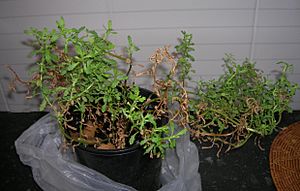Old man weed facts for kids
Quick facts for kids Old man weed |
|
|---|---|
 |
|
| A potted old man weed | |
| Scientific classification | |
| Kingdom: | |
| (unranked): | |
| (unranked): | |
| (unranked): | |
| Order: | |
| Family: | |
| Genus: |
Centipeda
|
| Species: |
C. cunninghamii
|
| Binomial name | |
| Centipeda cunninghamii (DC.) A.Braun & Asch.
|
|
| Synonyms | |
|
Cotula cunninghamii F.Muell. |
|
Centipeda cunninghamii is a type of flowering plant that belongs to the daisy family, Asteraceae. Most people know it as Old Man Weed. This name comes from its original Koori name, gukwonderuk. It was also sometimes called "common sneezeweed" or "scent weed" by early European settlers, but these names aren't used much anymore.
Indigenous Australians used this plant for its special healing qualities. You can often find Old Man Weed growing near the Murray River and in other wet places. It likes low-lying or swampy areas. You can spot it by its unique leaf shape and its strong, fresh smell, which is a mix of pine and mint.
Contents
What's in a Name?
The name Centipeda comes from a Greek word meaning "one hundred feet." The second part of its name, cunninghamii, honors a famous English botanist and explorer named Allan Cunningham. He lived from 1791 to 1839. Allan Cunningham was well-known for his trips to Australia and New Zealand. He collected many different plants and wrote books about the plants he found.
Plant Characteristics
Old Man Weed is a native Australian plant. It's a perennial herb, which means it lives for more than two years. It's part of the Daisy family, also known as Asteraceae. This plant usually grows straight up or slightly angled, reaching about 20 centimeters (8 inches) tall. It often has many branches.
Leaves
The leaves of Old Man Weed are shaped like an oblong or a spoon. They are about 15 millimeters (half an inch) long and 3-4 millimeters (about a tenth of an inch) wide. The edges of the leaves might have small teeth or be mostly smooth. They narrow down towards the base, but they don't have a clear stem.
Flowers
This plant has tiny, round flowers that are usually green. Sometimes, they can also be red or pink. These flower heads are small, about 4-8 millimeters (a fifth of an inch) across. They usually grow alone. The plant has different types of small flowers within each head. Some are female, and others have both male and female parts.
Fruit
After flowering, Old Man Weed produces small fruits called achenes. These fruits are shaped like clubs and are about 2 millimeters long. They have a rounded top and are smooth above their ridges.
Where Old Man Weed Grows
Old Man Weed usually grows in damp areas that might get flooded. It can grow in many different types of soil. You can find it in almost all parts of mainland Australia, including Queensland, Victoria, Tasmania, Western Australia, South Australia, and the Northern Territory. It also grows in New Zealand. Sometimes, it has even been found in Europe, likely carried there by accident.
Habitat
This plant lives in areas from the coast up to mountains, as high as 600 meters (about 2,000 feet) above sea level. It is very common in muddy or silty ground left behind when water levels drop. This includes the edges of lakes, ponds, streams, and rivers. You might also see it in muddy dips within grassy fields, paddocks, or even in damp spots in towns.
Life Cycle and Reproduction
Old Man Weed typically flowers from spring to autumn, which is usually from September to February. It produces fruit from October to June. This plant is quite easy to grow from fresh seeds or from cuttings. However, it can spread very quickly and might take over an area if not managed.
Traditional Uses
For a very long time, Indigenous Australians have used Centipeda cunninghamii as a traditional medicine. They used it to help with wounds, infections, and swelling. One common way to use it was to tie the leaves directly onto the forehead or other parts of the body. The warmth from the body would release the plant's natural oils, which would then soak into the skin.
Sometimes, the plant was also taken by mouth. People might mix it with emu fat or boil it in water to make a tea. When taking it orally, traditional healers knew it was important to use the correct amount. This was because using too much of the plant could be harmful.
See also
 In Spanish: Centipeda cunninghamii para niños
In Spanish: Centipeda cunninghamii para niños

